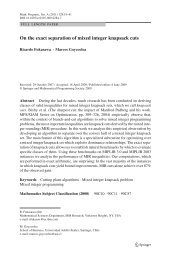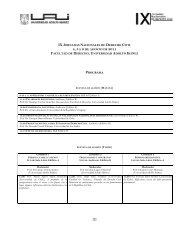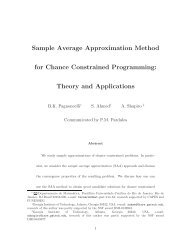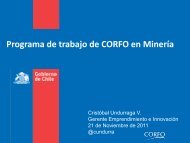Stability analysis of the oligopoly problem and variations Bernardo ...
Stability analysis of the oligopoly problem and variations Bernardo ...
Stability analysis of the oligopoly problem and variations Bernardo ...
You also want an ePaper? Increase the reach of your titles
YUMPU automatically turns print PDFs into web optimized ePapers that Google loves.
<strong>Stability</strong> <strong>analysis</strong> <strong>of</strong> <strong>the</strong> <strong>oligopoly</strong> <strong>problem</strong> <strong>and</strong> <strong>variations</strong><br />
BERNARDO KULNIG PAGNONCELLI 1 , RAFAEL DE CARVALHO CAYRES PINTO 2 ,<br />
MIGUEL ADRIANO KOILLER SCHNOOR 1 AND CARLOS FREDERICO BORGES PALMEIRA 1<br />
1 Department <strong>of</strong> Ma<strong>the</strong>matics — Pontifícia Universidade Católica — Rio de Janeiro — Brazil<br />
2 Department <strong>of</strong> Economics — Pontifícia Universidade Católica — Rio de Janeiro — Brazil<br />
bernardo@mat.puc-rio.br. cayres@gmail.com. miguel@mat.puc-rio.br.<br />
fredpalm@mat.puc-rio.br.<br />
Abstract. In this paper we study <strong>the</strong> dynamical formulation <strong>of</strong> <strong>the</strong> n-firm Cournot <strong>oligopoly</strong> model <strong>and</strong> <strong>variations</strong>.<br />
We consider both discrete <strong>and</strong> continuous cases <strong>and</strong> discuss its stability as well as its long-term behavior. As <strong>the</strong>se<br />
resulting models are linear, we propose <strong>the</strong> use <strong>of</strong> techniques from linear algebra such as Shermann-Morrison’s<br />
formula <strong>and</strong> Sylvester’s Law <strong>of</strong> Inertia to deal with <strong>the</strong>m. We describe an algorithm to approximate <strong>the</strong> eigenvalues<br />
<strong>and</strong> eigenvectors associated to <strong>the</strong> systems <strong>and</strong> illustrates <strong>the</strong> techniques with a simple example.<br />
Keywords: <strong>oligopoly</strong> <strong>problem</strong>. eigenvalues. Shermann-Morrison formula.<br />
1 Introduction<br />
In this work we apply known techniques <strong>of</strong> eigenvalue <strong>and</strong> eigenvector calculation to <strong>the</strong> Cournot <strong>oligopoly</strong> model. Our<br />
main goal is to study <strong>the</strong> general n-firm case <strong>and</strong> to provide efficient numerical methods to approximate <strong>the</strong> solution <strong>of</strong> <strong>the</strong><br />
resulting systems. O<strong>the</strong>r authors have already concerned about this more general setting. In [4], Theocharis gives <strong>the</strong> long<br />
term behavior <strong>of</strong> <strong>the</strong> dynamic Cournot model for a simple case, with an arbitrary number <strong>of</strong> firms. His conclusion is that for<br />
more than 3 firms <strong>the</strong> solution is always unstable. Fisher (see [2]) considered a wider class <strong>of</strong> models, which incorporates<br />
increasing marginal costs, <strong>and</strong> extends Theocharis results for <strong>the</strong> n firm model. He also provided sufficient conditions on <strong>the</strong><br />
parameters <strong>of</strong> <strong>the</strong> model in order to guarantee <strong>the</strong> stability <strong>of</strong> <strong>the</strong> system.<br />
In <strong>the</strong> next section we briefly describe Cournot’s approach to <strong>the</strong> <strong>problem</strong> <strong>and</strong> derive <strong>the</strong> response curves for each firm. In<br />
section 3 we introduce time in <strong>the</strong> model in both discrete <strong>and</strong> continuous settings. Variations <strong>of</strong> <strong>the</strong> model such as quadratic<br />
production cost are also described. In section 4 we start with a simple case where an explicit answer is obtained, similar to [4].<br />
Fur<strong>the</strong>r, we introduce <strong>the</strong> ma<strong>the</strong>matical formalism <strong>and</strong> necessary techniques to study stability <strong>and</strong> long-term behavior <strong>of</strong> <strong>the</strong>se<br />
models. In section 5 we exemplify one <strong>of</strong> <strong>the</strong> techniques in a simple example <strong>and</strong> analyse its computational performance.<br />
2 The classical Cournot model<br />
The Cournot <strong>oligopoly</strong> model has been extensively studied. It is a model that considers n firms producing <strong>the</strong> same<br />
product competing for <strong>the</strong> market. The firms decide simultaneously <strong>the</strong> output <strong>and</strong> <strong>the</strong>y all sell <strong>the</strong>ir product at <strong>the</strong> market<br />
clearing price. According to [5], <strong>the</strong> equations that define <strong>the</strong> model are<br />
p = K − Q<br />
n∑<br />
Q =<br />
i=1<br />
q i<br />
C i = k i q i , i = 1, . . .,n,<br />
where p is <strong>the</strong> common selling price, K is an arbitrary constant, q i is <strong>the</strong> output <strong>of</strong> firm i, Q is <strong>the</strong> total amount <strong>of</strong> <strong>the</strong> product<br />
available in <strong>the</strong> market <strong>and</strong> C i is <strong>the</strong> cost <strong>of</strong> production <strong>of</strong> firm i. One can define <strong>the</strong> production cost as any increasing<br />
function f(q i ), such as q 2 i or arctan(q i) for example. We start using <strong>the</strong> linear function f(q i ) = k i q i <strong>and</strong> later we consider<br />
Preprint MAT. 22/06, communicated on September 25 th , 2006 to <strong>the</strong> Department <strong>of</strong> Ma<strong>the</strong>matics, Pontifícia Universidade Católica — Rio de Janeiro,<br />
Brazil.

















